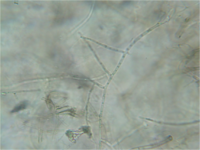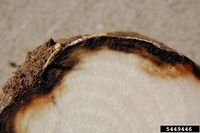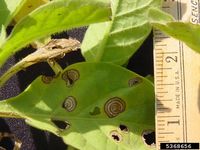Rhizoctonia solani
| Literature database |
|---|
| 1650 articles sorted by: |
| • year (descending) |
| • research topics |
| • countries/regions |
| • host plants |
| • list of antagonists |

Author(s): Gerald Holmes, Valent USA Corporation
Source: IPM Images
Rhizoctonia solani J.G. Kühn 1858
The fungus is very common, soil-borne and has a world-wide distribution. It infects many types of plants, causing rots, blights and other diseases of potatoes (black scurf and stem canker), soybeans (root and hypocotyl rot), cereals (crater disease of wheat, sheath blight, banded leaf of maize), vegetables, ornamentals, groundnuts (limb rot), or stored vegetables and fruits.
The black, hardened sclerotia (melanised hyphae) are the main durable stage of the fungus. These can survive in the soil for many years. The fungus does not produce asexual spores (conidia), but can form sexual spores (basidiospores) which disperse through the air and may be important for the disease development in certain crops.
| Vernacular names | |
|---|---|
| • Deutsch: | Spitzer Augenfleck Scharfer Augenfleck Blattscheidendürre von Reis |
| • English: | sharp eyespot sheath blight of cereals crater disease of wheat rice sheath blight black scurf of potato potato black scurf banded leaf of maize hypocotyl rot of soybean maize sheath blight |
| • Español: | costra negra de la papa |
| • Français: | rhizoctonie de la pomme de terre fonte des semis du riz |
Disease outbreaks commonly develop under warm and moist conditions. Although symptoms on roots are very common, leaves, fruits and other above-ground plant-parts may also develop symptoms.
Rhizoctonia solani f. sp. sasakii (the teleomorph Thanatephorus sasakii is used by some authors) causes sheath blight of rice.
Synonyms:
Corticium sasakii
Thanatephorus cucumeris (teleomorph synonym)
Thanatephorus sasakii
For a review and management on soybeans see Ajayi-Oyetunde & Bradley (2018).
- Other images of Rhizoctonia solani (IPM Images and Wikimedia Commons - click to enlarge)







